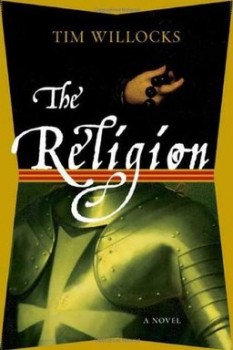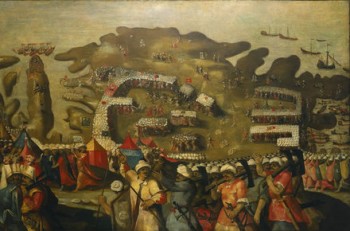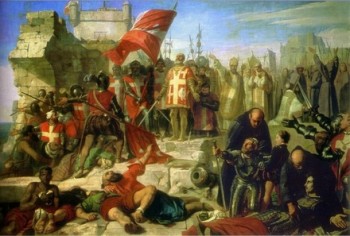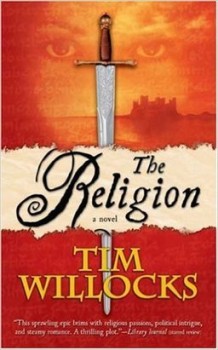The Religion by Tim Willocks
 One of sword & sorcery’s primary inspirations is historical adventure, like that of writers Harold Lamb and Talbot Mundy. That noble genre continues today in Tim Willocks’ insanely violent The Religion: Vol 1 of the Tannhauser Trilogy (2006), for one, set in the cauldron of the Great Siege of Malta. Into it, Willocks introduces the rogue Mattias Tannhauser, son of a Saxon blacksmith from Transylvania. At the age of 12, Mattias’ mother and sister are killed by Ottoman militia and he is taken captive. Every five years, the Turks would take Christian boys, convert them, and raise them up to be ferocious, elite soldiers, known as the Janissaries.
One of sword & sorcery’s primary inspirations is historical adventure, like that of writers Harold Lamb and Talbot Mundy. That noble genre continues today in Tim Willocks’ insanely violent The Religion: Vol 1 of the Tannhauser Trilogy (2006), for one, set in the cauldron of the Great Siege of Malta. Into it, Willocks introduces the rogue Mattias Tannhauser, son of a Saxon blacksmith from Transylvania. At the age of 12, Mattias’ mother and sister are killed by Ottoman militia and he is taken captive. Every five years, the Turks would take Christian boys, convert them, and raise them up to be ferocious, elite soldiers, known as the Janissaries.
For thirteen years, Tannhauser served as a true and loyal soldier of the sultan, but eventually he leaves and returns to the West. A dozen of so years later, Tannhauser and a pair of friends, English soldier Bors of Carlisle and Sabato Svi, Jewish trader, have established themselves as important arms and opium dealers in Messina, Sicily.
Now, as the Ottoman tide is ready to break on Malta, Jean de Valette, Grand Master of the Knights of St. John, lures Tannhauser to Malta. The great powers, Spain and France, embroiled in their own internal problems, have lent only token aid to the island’s defense. De Valette wants every resource he can lay his hands on, and what better than Tannhauser’s intimate knowledge of the Turks he once served with?
In the 16th century, the centuries long struggle between Christendom and the Moslem world seemed to be coming to a conclusion. In the century following the fall of Constantinople to the Ottoman Turks in 1453, the Christian West seemed headed for ultimate defeat. Under the brilliant Suleiman the Magnificent, the Knights of St. John, one of the last remaining military orders, had been driven out of the Eastern Mediterranean when Rhodes was captured in 1522. The knights, also known by their nickname the Religion, had been established in in 1099 to escort pilgrims to the Holy Land.

By 1565, the Knights were reduced to controlling only the tiny island of Malta. But the direction of the great clash of civilizations would change when a tiny force of under 5,000 held the island for 117 days, and inflicted tremendous casualties on an Ottoman army of 70,000. Starting there, the tide gradually turned against the Ottomans, and eventually the West would come to dominate global affairs.
The plan to bring the ex-Janissary to Malta involves introducing him to the widow, Lady Carla Penaultier. She hopes to find on Malta the son she bore out of wedlock and was forced to give up twelve years earlier. Tannhauser plans to find her son, if possible, and then sneak them off the island and back the safety of Sicily. Despite meticulous planning and a savagely self-serving nature, he becomes trapped by events and central to the ferocious siege.
The Religion is historical adventure of the first rank. The past was a different world, where there were men moved by faith and a belief in divine destiny to violence and eschewed worldly comforts to a degree that might seem alien to many modern Western readers, and war was up close and visceral. Willocks recreates the people, and the time and place of the siege, in sometimes terrible, but always vivid and spellbinding, detail.
Jean Parisot de La Valette, the Order’s Grand Master, stood at his table of maps with the great Colonel Pierre Le Mas. Tall and austere, in a long black habit emblazoned with the Cross of Saint John, La Valette was seventy-one. Fifty years of killing on the high seas had forged his sinew and so, perhaps, he knew wherof he spoke. At twenty-eight he’d survived the blood-soaked tragedy of Rhodes, when the tattered remnant of the Order had been exiled to the waves in the last of their ships. At forty-seven he’d survived a year as a slave in the galley of Abd-ur Rahman. When others would have taken high office within the Order — and on the safety of land — La Valette had chosed decades of ceaseless piracy, his nostril stuffed with tobacco against the stench. His brow was high and his hair and beard were now silver. His eyes had been bleached by the sun to the color of stone. His face seemed cast from bronze. To him news of the invasion was like some rejuvenating elixir in an Attic myth. He’d embraced the prospect of doom with the ardor of a lover. He was tireless. He was exuberant. He was inspired. What La Valette hated was Islam and all its evil works. What he loved was God and the Religion. And in these last of his days, God had sent the Religion the blessing of War. War at its apotheosis. War as manifestation of Divine Will. War unfettered and pure, to be fought to its smoking conclusion through every conceivable extreme of cruelty and horror.
In scenes of desperate violence cranked up to 11, the do-or-die battle ranges from the heights of the island’s fortress walls down into tunnels underground. The stink of gunpowder, burning and rotting flesh surges off the page in great stomach churning clouds. Willocks spent years working as a scriptwriter and produced in Hollywood and there is a tremendous cinematic quality to the book.
The martial rhythms of the Mehterhane, the stomp of thousands of feet, the clank of metal, the shrill descant of the imam’s pleas to Allah fashioned themselves into a mighty wheel of sound which rolled from the flame-lambent shadows beyond the ditch. In its wake five janissary orta, horsehair standards aloft and banner written with the Shahada aflutter, roared from the throat of night and flung themselves at the causeways and across the corpse-swollen ditch.
The Christians goaded them on with a howling invitation to the dance. Mixed within it Tannhauser heard a Babel of prayers in Latin and a clutch of vulgar tongues. To Santa Catarina and Sant’Agata. To Sant’Iago and San Pablo. To Christ and the Baptist. Pray for us sinners. Thy kingdom come. Thy will be done. Now and at the hour of our death. Amen. The most popular invocation, as if the man were beatified already, was La Valette and the Holy Religion.
At twenty yards the oncoming ranks unleashed a shower of humbaras, the burning fuses tailing showers of sparks. Tannhauser watched them arc over, poised to leap away, but luck was with him. They sailed overhead and he felt flares of heat behind him and squalls of horror and panic but didn’t turn. At the same time the Devil’s bondsmen in the Order’s firework crews unleashed squealing torrents of liquid death from the trumps, and huge burning hoops traced yellow spirals in the air as they sailed forth. The tightly packed janissaries were ensnared by two and threes in these circles of flame. Their blue cotton robes flared up as if made of paper and like the damned chained together in perdition they tore at each other as they writhed and burned and died.
So fierce was the coruscation on either wing that the field incandesced as bright as noontide. Through this holocause the vanguard’s human tide roared on undaunted. They brandished a gallery of melee arms and with their wild eyes and long mustaches and tall white bonnets embellished with wooden spoons, they suggested a race of deranged cooks who’d been banished from the kitchen of a madhouse. They spilled into the ditch. They charged the burning bridges. They surged across the firedrenched causeways.

In bringing the titanic struggle’s cast of characters to life, Willocks avoids the pitfall of making them seem like contemporary people in fancy dismissing them for not being acting like us. The unbending Jean de Valette and his companions in the Religion rise out of the distant past, coming to life as soldiers completely devoted to the defense of the West no matter how hopeless and bleak their prospects look. On the other side, the Ottomans are a disturbing mixture of great civilization and bloodthirsty savagery. Despite Tannhauser’s cynicism about faith, Christian or Islam, Willocks is more nuanced. Despite the plethora of religious hypocrite, there are characters deeply inspired and moved by their belief, and they are not presented as fools or dupes. Even the vile inquisitor, Ludovico Ludivici, is inspired by a genuine desire to preserve Christendom against heresy.
At the center of novel is Mattias Tannhauser, a killer and plotter cut in the mold of sword-wielding adventures like Conan (Willocks is an avowed fan of Robert E. Howard) or Kane. He is swathed in scars and the tattoos of a Janissary. His allegiance is to himself and his few, close friends, not to any great cause or creed. He has seen too much wickedness at the hands of Christians and Moslems to have any faith in either one. The plight of the Knights and the Maltese leaves him unmoved and he has almost no qualms about deserting them.
Tannhauser’s first reaction when he sees a woman is to imagine what it would be like to sleep with her. He is a man of simple motivations – sex, drink, and wealth. He does whatever it takes to survive and thrive, whether it’s hoarding desperately needed opium or having a coffle of Moslem prisoners murdered to provide him cover to sneak into the Ottoman camp.
 At times Tannhauser comes across as maybe little too cosmopolitan and contemporary. He doesn’t allow prostitution in his tavern and he has spent time studying with a humanist scholar. What keeps him from becoming too modern is the deep history Willocks gives him in order to explain and justify his nature. He convinces the reader the ex-Janissary has seen and done way too much in his life. He is man who walks alone, apart from men to either side of him.
At times Tannhauser comes across as maybe little too cosmopolitan and contemporary. He doesn’t allow prostitution in his tavern and he has spent time studying with a humanist scholar. What keeps him from becoming too modern is the deep history Willocks gives him in order to explain and justify his nature. He convinces the reader the ex-Janissary has seen and done way too much in his life. He is man who walks alone, apart from men to either side of him.
What separates Willocks’ creation from so many other amoral protagonists is the price he pays for his actions. Through the course of the novel he must contend with losses he never expected and emotional entanglements he never contemplated. The world of The Religion is a vicious and unfair place but there is still room for hope and love and even Tannhauser can be reached by it. The Tannhauser who emerges from the end of the book is not the man from the beginning and his transformation feels earned and real.
The Religion is not for the squeamish. There is more blood, viscera, excrement, and severed limbs per page than any book I have read this side of a dozen 80’s splatterpunk novels. Often the only thing dividing one hyper-violent battle from another is an interlude of one on one violence. If graphic violence disturbs you, then this is not for you. Even the horses don’t escape the carnage.
The suffering of the horses felled by the battle was atrocious and moved him more than the screams of the men. The beasts floundered in wallows of blood, crippled and bewildered, or charged about blinded and insane, or hauled great unraveling sacs of yellow intestines between their hind legs and they stumbled for the plain.
Perhaps in keeping with the book’s clear pulp roots, much of the plot is driven by nearly miraculous coincidence. Tannhauser, Lady Carla, Ludovici move around each other in orbits that cross beyond the believable on more than one occasion. Events occur for seemingly no other reason but to stress a facet of a character’s nature. A certain mystery’s solution is no mystery at all, because it is clear it will be the most obvious and dramatic one. The love stories between Tannhauser and two separate women are intense and over-the-top. I loved all of it, myself. For all Willocks’ tremendous achievement at creating historical verisimilitude, his protagonists’ story operates at an exaggerated, operatic level that lends itself to such plot manipulation. In aims for the mythic, and much of the time, it succeeds.
There are moments of historical inaccuracy. Tannhauser reminiscences about participating in quashing a rebellion that occurred a over a century before his birth (* see correction below). I caught at least one linguistic anachronism. These are minor quibbles about an gut-wrenching, exciting book. With The Religion, Willocks has written a powerful story set during one of the most important moments in Western history. Into it he’s successfully woven the story of a man of violence trying to find his place in the universe and some kind of peace. This is a monumental work of storytelling that any lover of historical adventure should read.
The series’ second volume is The Twelve Children of Paris (2013) set during the Saint Bartholomew Day’s Massacre. It is not available in the US, which means when the time comes, I’ll have to buy it from the UK.
* CORRECTION: I failed in performing my due diligence while writing this review. The rebellion of the False Mustafa described in the novel is not the one I thought it was. There were several False Mustafas and there was indeed a rebellion against the the Great Sultan Suleiman the Magnificent in 1555, which fits perfectly into Mattias Tannhauser’s biography. Please forgive my sloppiness and let me offer a tremendous thank you to Mr. Willocks for taking the time to set me straight.
Fletcher Vredenburgh reviews here at Black Gate most Tuesday mornings and at his own site, Swords & Sorcery: A Blog when his muse hits him.
The Religion is possibly the best novel I have read in the past 20 years. It is as good as Robert McCammon’s Boy’s Life, but in a much different way, of course. Pulpy? If this is Pulp, gimme more! This is a book written by a man, for men. Literary snobs need not apply. Blood, guts, testosterone and titties; but so well written. Some images were so clear and beautiful, yet drenched in gore and machismo. The tale of the first red rose, as told by Tannhauser to Clara was heartbreakingly beautiful. Damn, I can’t believe I said that!
@darkman – Oh, it’s pulp, but I mean that in the most laudatory and affectionate way. This book’s roots go straight back to Lamb and Howard. It is a magnificent book.
I also cannot stress how great this book is, and it is also very accurate. For more on the Siege itself, see Roger Crowley’s Empires of the Sea. I have not read the sequel yet. Willocks’ other books are also quite good, particularly Blood Stained Kings and Green River Rising. The latter is one of the better prison novels written in the last 35 years.
FWIW, there are plenty of copies of Twelve Children up on the US Amazon site — all from third-party sellers, of course.
I can confirm that The Twelve Children of Paris is bloody, brutal, heart wrenching and often beautiful. I highly recommend it. Picked up my copy at Half Price Books.
@Peter – I loved Crowley’s book and recommend it to anyone who like The Religion. I remember the buzz when Green River Rising came out, but never picked it up. Definitely will now.
@Joe and jotfiend – a copy of Twelve Children is winging its way to me right now
I echo the effusive praise of “The Religion.” Truly one of the greatest depictions of battle ever penned.
@Ken – absolutely. It also reminded me of Ernst Junger’s Storm of Steel. The combat is depicted without an ounce of false glory but its deadly allure is presented as well.
How did I miss this review, Fletcher?
Yes, absolutely, anyone with a scintilla of taste for powerful, profound writing should read this book. Tannhauser is one of the great literary characters and THE RELIGION is and will be the THE ILIAD of the 21st century. Tim Willocks is our Homer, God help us all.